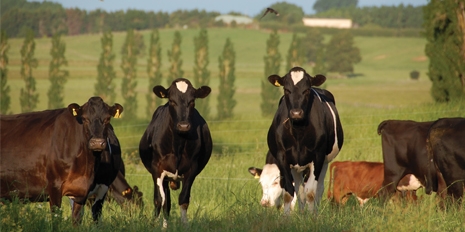
After many years of running sessions at the studio, we threw the doors open for the first public 'Inspiration Session' at the Library Bar at the Mount.
Dion Cawood (Lead Business Development Manager), David Chin (Key Account Manager), and Guy Irvine (Rapid Prototyping Software Architect) ventured over the Kaimais from their base at Livestock Improvement Corporation (LIC) in the Waikato to talk to the crowd about 'Starting New Innovative Activities in a Corporate Environment'.
LIC is one of those businesses that does a whole lot of stuff which you hear very little about. They are a dairy farmer owned cooperative that provides genetics and on-farm technology to support ongoing improvements in dairy performance. They have 700 staff at their HQ covering a huge range of disciplines and can run up to a seasonal peak of several thousand people. Their products are wide ranging and there is constant R&D behind these products to continue to evolve them.
We have worked with LIC and can reflect that they have a talented team of people doing some amazing work across genetics and life sciences, machine learning, physical technology & engineering, software development, and IT infrastructure (to name a few).
One of the most compelling statistics we heard through our involvement is that LIC has delivered and locked in 1.6% productivity improvement (compounding) each year since 1960 through the use of science and technology. But, as with a lot of large organizations, evolving to meet the present and future needs is an ongoing challenge. It requires a constant and ruthless evolution of processes which, at times, can be uncomfortable.
Cawood and Chin somehow convinced their CEO to give them a shot at doing it differently. Their focus was LIC's large multi-heard customers who appeared to have different issues and day to day needs. The existing software product, Minda, had proved extremely successful with individual farmers but perhaps did not cater so well to the specific requirements of a large farming organisation. Things like inventory and stock movements all of a sudden become major financial considerations.
As Cawood said, “LIC took the leap of faith” and approved a Skunkworks team with David, Dion, and Guy as the software architect. They moved from their respective abodes around the large LIC campus to work next to each other (to aid collaboration and discussion). The goal was to create a different way of working, one that bypassed some normal project approvals, and enabled a rapid and real prototyping approach that allowed things to be tried and failed in a closed environment with real customers. It affords a proximity to customers that clearly removes any bias developed by sitting and thinking about what exciting new things you can do, and focuses the mind on delivering (today) what is required (for tomorrow). All with an immediate feedback loop of whether it actually worked.
A great example was the CFO of a large farming company talked to one of the Key Accounts team with a seemingly simple challenge of, "How do I simply track our cows across their many farms?" A task traditionally dealt with by putting a stock agent in and doing a physical stock take; a tedious, time consuming task. Within 48 hours, this had been replaced by an automated software solution that enabled them to easily see where stock was.
What the team are not trying to do is to engineer a production software solution. Rather they are trying to rapidly create accurate and well thought through solutions. If it is successful, proven to work and provide value, it can be introduced into the formal structured software development cycle.
So this is not so much a substitution of the production software development, it is more of an active learning and development environment. Perhaps we can call this the love child of Agile and Learning First (potentially it could add another acronym to the universe: 'ALF'?)
The results to date have been compelling; they have some very happy customers who are dynamically engaged in the development of products that will ultimately benefit them.
Cawood and Chin were careful to differentiate between the entry point of a customer idea and a customer problem statement; an idea from a customer can sometimes results in nice-to-have functionality but is not necessarily useful; starting with a problem statement will inherently develop into a useful solution helping the customer. It’s the Customer Relationship Manager's role to distil the farmer’s request into a problem statement as a foundation to the solution development.
In keeping with the inspirational theme the three talked about the people who inspired them. Here is a selection:
The inspirational part of this story comes from the courage these guys had to try something different, and put it on the line to deliver results.
Cawood and Chin worked creatively to circumvent the internal bottlenecks and develop a system that delivers real customer benefits in useful time-frames.
Thanks to Dion, David & Guy for coming over and sharing their experience, and the Library Bar (at the Astrolabe) for generously agreeing to host these events.
Comments
Post new comment